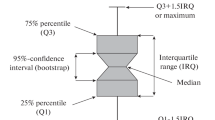Abstract
In this paper, Tseng and Lee's parallel algorithm to solve the stable marriage prolem is analyzed. It is shown that the average number of parallel proposals of the algorithm is of ordern by usingn processors on a CREW PRAM, where each parallel proposal requiresO(loglog(n) time on CREW PRAM by applying the parallel selection algorithms of Valiant or Shiloach and Vishkin. Therefore, our parallel algorithm requiresO(nloglog(n)) time. The speed-up achieved is log(n)/loglog(n) since the average number of proposals required by applying McVitie and Wilson's algorithm to solve the stable marriage problem isO(nlog(n)).
Similar content being viewed by others
References
Allison, L.,Stable marriages by coroutines, Information Processing Letters, Vol. 16, No. 2, Feb. 1983, pp. 611–65.
Gale, D. and Shapley, L. S.,College admissions and the stability of marriage, Am. Math. Monthly 69, 1962, pp. 9–15.
Hull, M. E. C.,A parallel view of stable marriages, Information Processing Letters, Vol. 18, No. 1, Feb. 1984, pp. 63–66.
Kapur, D. and Krishnamoorthy, M. S.,Worst-case choice for the stable marriage problem, Information Processing Letters, Vol. 21, July 1985, pp. 27–30.
Knuth, D. E.,The Art of Computer Programming, Vol. 1/Fundamental Algorithms, 2nd Edition, Addison-Wesley, Reading, Mass., 1973.
McVitie, D. G. and Wilson, L. B.,Stable marriage assignment for unequal sets, BIT 10, 1970, pp. 295–309.
McVitie, D. G. and Wilson, L. B.,The stable marriage problem, Communication of the ACM, Vol. 14, No. 7, July 1971, pp. 486–490.
McVitie, D. G. and Wilson, L. B.,Algorithm 411, Pts. 1–3. Three procedures for the stable marriage problem, Communication of the ACM, Vol. 14, No. 7, July 1971, pp. 491–492.
Quinn, M. J.,A note on two parallel algorithms to solve the stable marriage problem, BIT 25, 1985, pp. 473–476.
Shiloach, Y. and Vishkin, U.,Finding the maximum, merging, and sorting in a parallel computation model, Journal of Algorithms, Vol. 2, 1981, pp. 88–102.
Tseng, S. S. and Lee, R. C. T.,A parallel algorithm to solve the stable marriage problem. BIT 24, 1984, 308–316.
Valiant, L. G.,Parallelism in comparison problems, SIAM Journal of Computing, Vol. 4, No. 3, Sep. 1975, pp. 348–455.
Wilson, L. B.,An analysis of the stable marriage assignment algorithm. BIT 12, 1972, pp. 569–575.
Author information
Authors and Affiliations
Rights and permissions
About this article
Cite this article
Tseng, S.S. The average performance of a parallel stable marriage algorithm. BIT 29, 448–456 (1989). https://doi.org/10.1007/BF02219230
Received:
Revised:
Issue Date:
DOI: https://doi.org/10.1007/BF02219230




